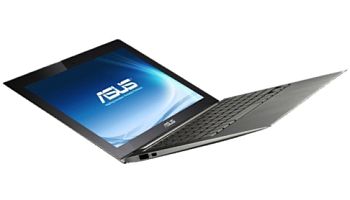Asus Launches ‘Zenbooks’

Asus is following Acer’s lead into the ultrabook market with two new thin-and-light systems
Asus, a day after Acer introduced the first of its ultrabooks, is readying two of its own ultra thin and light laptops to hit the market on 12 October.
Asus executives on 11 October announced what they are calling Zenbooks, the 11.6-inch UX21 and the 13.3-inch UX31, two systems that are joining Acer’s Aspire S3-951 as among the first entrants in the ultrabook category being championed by chip giant Intel.
Thin and light
Asus Chairman Jonney Shih announced the new Zenbooks at a launch event in New York.
Intel officials first introduced the idea of ultrabooks at the Computex 2011 show in May, proposing thin and light laptops that offer the benefits of traditional systems with many of the features found in tablets, including long battery life, instant-on capabilities and constant Internet connection. They’ve called on ultrabooks to be less than 0.8 inches thick and come in priced at less than $1,000 (£640).
 They’re aimed at competing with the increasingly popular tablets as well as with Apple’s ultra thin and light MacBook Air, the lowest-end model of which costs $999. Intel officials also see ultrabooks as a way of boosting sales in the slumping PC market.
They’re aimed at competing with the increasingly popular tablets as well as with Apple’s ultra thin and light MacBook Air, the lowest-end model of which costs $999. Intel officials also see ultrabooks as a way of boosting sales in the slumping PC market.
Ultrabooks also will help Intel in its push to become a larger player in the mobile computing market.
Acer’s Aspire S3 is being priced at $899; Asus’ UX21 starts at $999. The Zenbook UX31 will be priced starting at $1,099, and going up as high as $1,499. The UX21, with its brushed metal exterior, is about .13 inches thick at its thinnest part. Like tablets and Acer’s system, the Zenbook can boot up quickly, in about two seconds out of standby mode.
The systems from both Acer and Asus are powered by Intel’s Core “Sandy Bridge” processors and run Microsoft’s Windows 7.
Storage technology
A key difference between Acer’s Aspire S3 and Asus’ Zenbooks is in the storage technology being used. Asus’s systems use 128GB hybrid solid-state disk (SSD), while Acer uses a combination of a 20GB SSD and a 320GB hard drive. The SSD store the Aspire’s operating system and maintain the ultrabook’s current state so that it can restore the laptop to its previous state when coming out of Sleep or Deep Sleep mode, according to Acer.
In addition, whereas the Aspire S3 comes with a USB 2.0, Asus’ systems feature USB 3.0, which Shih said is 10 times faster than USB 2.0. The hybrid approach with the SSD and hard disk drive, and using USB 2.0 over USB 3.0, helped Acer bring in the Aspire S3 in at $899.
Intel executives have been adamant about keeping the pricing below $1,000, enabling it to better compete with tablets and the MacBook Air. Reports earlier this year had OEMs pushing Intel for help in driving the costs down, including in getting a price break on Intel chips. Intel created a $300 million fund to invest in vendors making hardware and software solutions for ultrabooks.
Toshiba and Lenovo also are looking at selling ultrabooks, though their prices currently are coming in higher than $1,000.
Intel sees a three-step progression in the development of ultrabooks, starting with the first ones built with processors using the current Sandy Bridge architecture. Next year, systems powered by Intel’s upcoming “Ivy Bridge” chips will hit the market, followed in 2013 by “Haswell” processors.